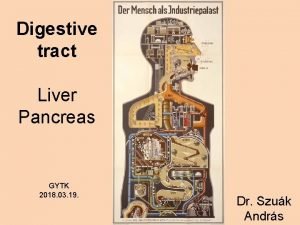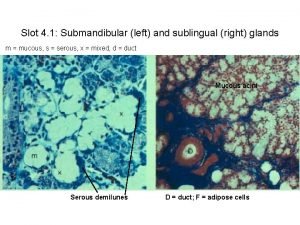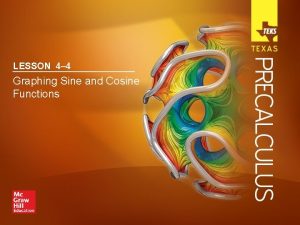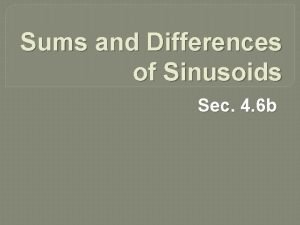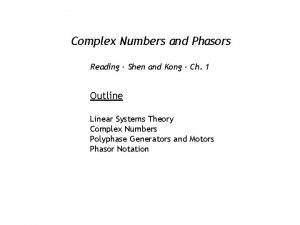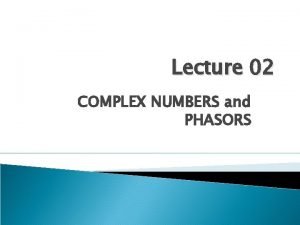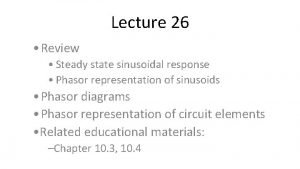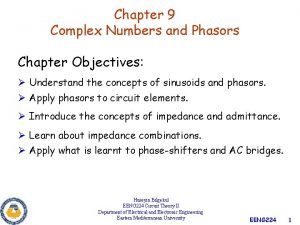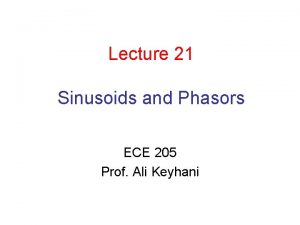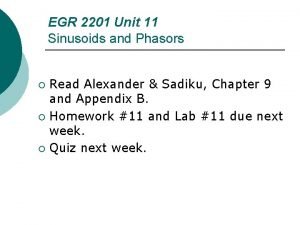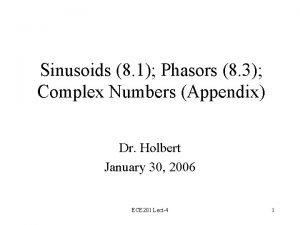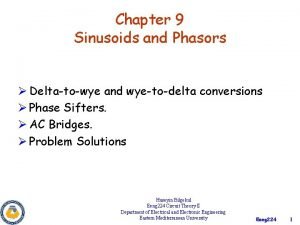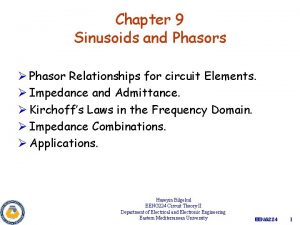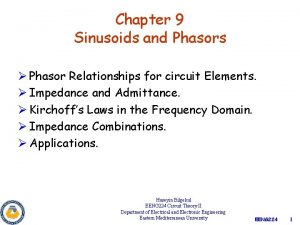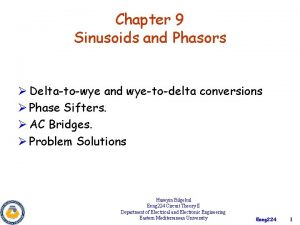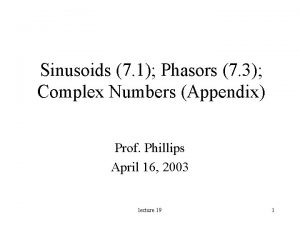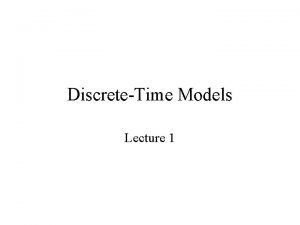Lecture 4 Phasors DiscreteTime Sinusoids Sections 1 4





![Discrete-Time Signals • A discrete-time signal is a sequence of values (samples) x[n], where Discrete-Time Signals • A discrete-time signal is a sequence of values (samples) x[n], where](https://slidetodoc.com/presentation_image/035641bc1dc137745ec3a6005f22ff19/image-6.jpg)



![Classwork • Find simple expressions for x[n]= A cos(ωn + φ) when ω = Classwork • Find simple expressions for x[n]= A cos(ωn + φ) when ω =](https://slidetodoc.com/presentation_image/035641bc1dc137745ec3a6005f22ff19/image-10.jpg)
![Fundamental Period • The fundamental period of x[n] is the smallest integer N such Fundamental Period • The fundamental period of x[n] is the smallest integer N such](https://slidetodoc.com/presentation_image/035641bc1dc137745ec3a6005f22ff19/image-11.jpg)

- Slides: 12

Lecture 4: Phasors; Discrete-Time Sinusoids Sections 1. 4, 1. 5

Key Points • The stationary phasor of Acos( t + ) is the complex number Aej. The sum of two (or more) sinusoids of arbitrary amplitudes and phases but of identical frequency is a sinusoid of frequency . Sinusoids of identical frequency can be added together by taking the complex sum of their stationary phasors. • The discrete time parameter n counts samples. The (angular) frequency parameter is an angle increment (radians/sample). Physical time (seconds) is nowhere involved. • Frequencies and + 2 are equivalent (i. e. , produce the same signal) for real or complex sinusoids in discrete time. • Frequencies and 2 - can be used alternatively to describe a real sinusoid in discrete time: cos( n + ) = cos(- n - ) = cos((2 - )n - ) • The effective range of frequencies for a real sinusoid in discrete time is 0 (lowest) to (highest). • A discrete-time sinusoid is periodic if and only if is of the form =(2 k/N) for integers k and N. The fundamental period is the smallest value of N for which the above holds.

Stationary Phasor • Since cos θ = Re{ejθ}, it follows that x(t) is the real part of the time-dependent complex sinusoid z(t) = Aej( t+ ) • On the complex plane, the point z(t) moves with constant angular velocity on a circle of radius A. Its projection on the real axis equals x(t). The initial position z(0) = Aej , viewed as a vector, is known as the stationary phasor of x(t).

Addition of two sinusoids • Two real-valued sinusoids of the same frequency can be added together: A 1 cos(Ωt + φ1)+ A 2 cos(Ωt + φ2)= Re{A 1 ej(Ωt+φ1) + A 2 ej(Ωt+φ2)} = Re{(A 1 ejφ1 + A 2 ejφ2 )ejΩt} = A cos(Ωt + φ) where Aejφ = A 1 ejφ1 + A 2 ejφ2 • The result is a sinusoid of the same frequency, whose stationary phasor is the complex (i. e. , vector) sum of two component stationary phasors.

Example 2. 7 cos(15πt +0. 6) + 4. 1 sin(15πt − 1. 8) = A cos(15πt + φ) where Aejφ =2. 7 ej 0. 6 +4. 1 ej (− 1. 8−π/2) • We convert each term to its Cartesian form, compute the sum and convert back to polar form to obtain A =3. 0241 and φ =2. 1937. • Your task: Fill in the missing steps.
![DiscreteTime Signals A discretetime signal is a sequence of values samples xn where Discrete-Time Signals • A discrete-time signal is a sequence of values (samples) x[n], where](https://slidetodoc.com/presentation_image/035641bc1dc137745ec3a6005f22ff19/image-6.jpg)
Discrete-Time Signals • A discrete-time signal is a sequence of values (samples) x[n], where n ranges over all integers. A discrete-time sinusoid has the general form x[n]= A cos(ωn + φ) or, in its complex version, z[n]= Aej(ωn+φ) • Question: How is x[n] related to z[n]?

Matlab Example • Use MATLAB to generate 100 values of each of the discrete-time sinusoids x 1[n] and x 2[n]: n = 0: 99; w 1 = pi/25; q 1 = 2*pi/5; x 1 = cos(w 1*n + q 1); w 2 = 2. 4; q 2 = -1. 3; x 2 = cos(w 2*n + q 2); bar(n, x 1) % discrete bar graph plot(n, x 1), grid % extrapolated graph bar(n, x 2) % no resemblance to a continuous-time sinusoid • Depending on its frequency, a discrete-time sinusoid may look similar to, or quite different from, a continuous-time one.

Frequency of a Discrete-Time Sinusoid • The frequency parameter ω is measured in radians, or radians per sample. (Unlike Ω, which is in radians per second). Thus the frequency of a discrete-time sinusoid is just an angle increment: the argument of cos(·) increases by a fixed amount ω with each sample. • Two key observations: ▫ ω and ω +2 kπ, where k is an integer, represent the same frequency. This is because ωn and (ω +2 kπ)n differ by 2 knπ radians, i. e. , a whole number of revolutions, and therefore at every time n, cos(ωn + φ) = cos((ω +2 kπ)n + φ) ej(ωn+φ) = ej((ω+2 kπ)n+φ) Typically, the range of ω is chosen as [0, 2π) or (−π, π]. ▫ In the real-valued case, either ω or −ω can be used to express the same sinusoid. This is due to the identity cos θ = cos(−θ), which implies that for every n, cos(ωn + φ) = cos(−ωn − φ) As a result, the range of ω for real-valued sinusoids can be limited to [0, π].

Frequency of a Discrete-Time Sinusoid
![Classwork Find simple expressions for xn A cosωn φ when ω Classwork • Find simple expressions for x[n]= A cos(ωn + φ) when ω =](https://slidetodoc.com/presentation_image/035641bc1dc137745ec3a6005f22ff19/image-10.jpg)
Classwork • Find simple expressions for x[n]= A cos(ωn + φ) when ω = 0 (lowest possible frequency) and ω = π (highest possible frequency). • Modify the MATLAB script given earlier to compute and plot 100 values of the high-frequency sinusoid x 3[n] = cos((24π/25)n +2π/5) Note that the frequencies of x 1[n] and x 3[n] are complementary to each other in the interval [0, π].
![Fundamental Period The fundamental period of xn is the smallest integer N such Fundamental Period • The fundamental period of x[n] is the smallest integer N such](https://slidetodoc.com/presentation_image/035641bc1dc137745ec3a6005f22ff19/image-11.jpg)
Fundamental Period • The fundamental period of x[n] is the smallest integer N such that (∀n) x[n + N]= x[n] • If no such N exists, then the signal is nonperiodic (or aperiodic). • The sequences cos(ωn + φ) and ej(ωn+φ) are repetitions of a fixed vector of N values if and only if the argument ωn + φ changes by an exact multiple of 2π every N time indices. In other words, if and only if ωN =2 kπ ⇔ ω = · 2πk/N for some integer k. • The smallest value of N satisfying the above relationship is the fundamental period.

Example • • • Shown is the fundamental period N (where periodic). ω =0 ⇒ N =1 ω = π ⇒ N =2 ω =1. 0 ⇒ N = ∞ (i. e. , nonperiodic) ω = 10π/13 ⇒ N = 13 ω = 11π/13 ⇒ N = 26 Note that for a periodic discrete-time sinusoid, the fundamental period does not necessarily equal 2π/ω (as was the case with continuous-time sinusoids).
